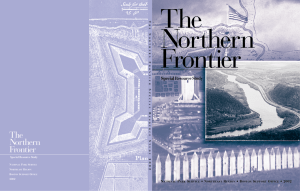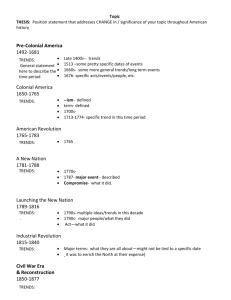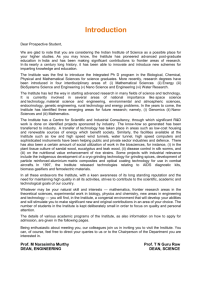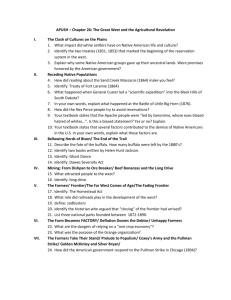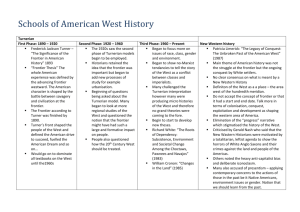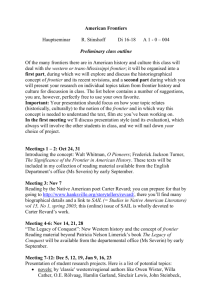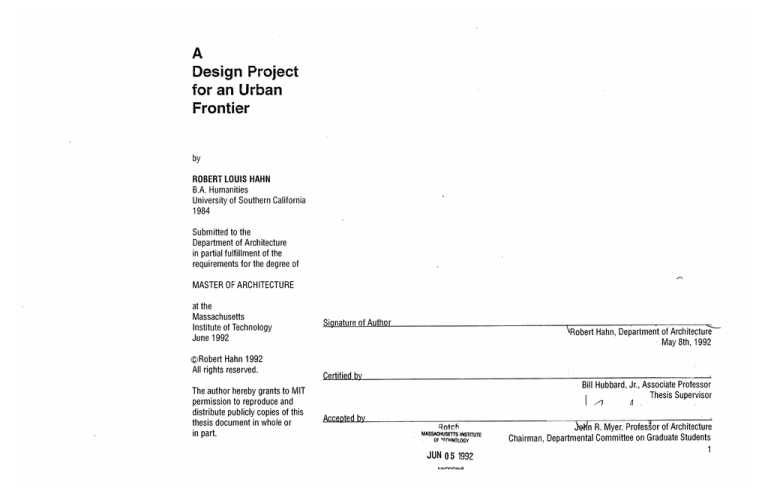
A
Design Project
for an Urban
Frontier
by
ROBERT LOUIS HAHN
B.A. Humanities
University of Southern California
1984
Submitted to the
Department of Architecture
in partial fulfillment of the
requirements for the degree of
MASTER OF ARCHITECTURE
at the
Massachusetts
Institute of Technology
June 1992
@Robert Hahn 1992
All rights reserved.
The author hereby grants to MIT
permission to reproduce and
distribute publicly copies of this
thesis document in whole or
in part.
Signature of Author1
\Robert Hahn, Department of Architecture
- May 8th, 1992
Certified by
Bill Hubbard, Jr., Associate Professor
Thesis Supervisor
Accepted by
Rotch
MASSACHUSETTS INSTITUTE
OF TrHN7jt3Y
JUN 05 1992
LdLrV-rflL.O
Jen R.Myer, Professor of Architecture
Chairman, Departmental Committee on Graduate Students
A Design Project for
an Urban Frontier
by
Robert Louis Hahn
Submitted to the Department of
Architecture on May 8th, 1992
in partial fulfillment of the
requirements for the Degree of
Master of Architecture
Abstract
The interplay between the form
and infrastructure of modern
cities produces spatial and
temporal dimensions which allow
for erratic growth and
fragmentary perception. Though
their origins can be clearly seen in
urban development since the
Renaissance, density, movement,
and pace in contemporary cities
increase as meaningful
boundaries are erased by rising
consumption of services and a
spate of traffic (automobile,
communication, utility). While
property values limit accessibility
to inner urban space, the city
expands outwardly, generally
following the path of least
resistance. In so doing, the
increased demands on
infrastructure cleave existing
urban textures, creating
anomalies in the landscape.
As a result, large open spaces
for public use are either
dislocated (to suburbia),
restricted (institutionalized where
most public), or simply "left over"
as remnants of previous
programs (abandoned buildings)
or the fall-out of large scale
construction (highways, public
transport, utilities, etc.).
The potential of these latter
spaces for public use is often
unrecognized. This thesis will
argue that due to their very
nature, cities produce such
spaces by default and that they
can be employed for public use as
a frontier in the urban psyche.
The design for such a frontier
would support a variety of
programs based on public events.
As soon as one event takes place,
another would follow according to
the rhythm of the city. In this
way, it could act as a stabilizer by
activating places which are really
just dormant and providing a
permanent fixture for civic
activity.
Thesis Supervisor: Bill Hubbard
Title: Associate Professor
3
4
CONTENTS
Preface
7
Site
13
Thesis
19
Design
31
Program
43
Sources
51
5
6
PREFACE
Aerial view of downtown Boston.
Surveying techniques.
It is inconceivable to imagine
the planning of cities without
surveying. Providing fixed points
for future reference and marking
new boundaries, it documents
and enables us to shape the
landscape from the scale of a
lightpole to that of the metropolis.
In placing his transit, the surveyor
takes a bearing on the transience
of the physical world, he fixes a
reference point by which one can
measure transformation in both
the natural and built
environments.
By ordering these points, one
can construct the totality of the
city or the smallest block. No
matter what the scale, an
overview is presented such that
one can take stock of the whole
as when looking at a map or an
aerial photograph. The
relationship of each part to
7
another is spatially clear like so
many points on a grid. The
experience of those parts,
however, remains detached.
Modern cities can be
characterized by the pace and
scale at which they are
transformed through building.
Over a period of a few years,
entire districts can be completely
re-built and the separation of
distant areas reduced to minutes.
Essential to the planning of urban
infrastructure and renewal
projects is the ability to view a
given area as a discrete part. On
this level, districts are legible as
entities connected or cut-off by
roads, highways, railway lines or
waterways. But as the spatial and
temporal dimensions of the city
are altered on such a large scale,
the perception of it becomes
more disjointed: the view the
8
Boston's West End in the sixties and in the
eighties.
skyline compared to being at the
foot of a skyscraper, or the
difference between following a
map and driving on the highway.
This disparity of perceiving the
"city" and actually inhabiting it is
a fundamental urban experience
of today. The subject of this
thesis is to develop a design
project for a site which elicits this
quality.
I. I
C1
9
10
1ff
III
1:1111111
IIIIIIffIffIIfIfffIfi~:*
*m:tri:s
3. a
31 ii
U.
2
uuuuwuu*.umg u..~. mu..-...
.. uu..u,..uu
ow
m
Ins a
mum,
mum a
M.~.
21~L1iiL
I
If!
I
!~
12
SITE
Bounded by elevated roadways
on three sides and Fort Point
Channel on the other, the site is
highly visible though difficult to
access. West Fourth Street to the
south is elevated on earth and
then by bridge; on the north side
lies Broadway which is supported
thirty feet above ground level by
massive masonry piers; and
Highway 93 (Central Artery) with
its on and off ramps and service
road, forms a wall to the west. Itis quite easy to loop around this
area by taking various
combinations of these roads. But
together with the Channel and the
many railway tracks which lie
beyond it, they cordon off the site
from adjacent areas. Due to their
dissimilarity, they attest the true
nature of the site itself: it was
created by default, simply left
over from successive waves of
13
large scale intervention : bridges,
highways, landfill, rail and subway
tracks.
Despite its proximity to the city,
it is cut-off from it by the very
infrastructural elements which
make it visually accessible. The
only way to get to the site is by
turning off Albany Street and
crossing under 93 where both
ramps and the service road are
sufficiently elevated.
Once on the site, the city
(downtown Boston) takes on a
different image; it is no longer the
place to which all roads lead, but
separated and objectified by
them. They frame the city by
creating visual discontinuity in the
foreground and an artificial
horizon above ground level. The
elevated roadbed is treated then
as an element in the urban
landscape just as grade changes
14
or the skyline of the city. The
Central Artery is thus a semipermeable wall and the Channel is
a sharply defined edge.
From both inside and outside
large scale shifts are visible.
Looking down from above, the
terrain of the site appears
continuous but contained. One
views the site from a dynamic
vantage point, the automobile,
panning across it along with the
rest of the city. But from within, a
foreshortening of urban space is
effected as the middle ground,
blocked by roads draws the city
closer to a fixed standpoint on the
site.
15
16
17
18
THESIS
Piazza del Campo, Sienna.
Monteriggioni, Italy.
Medieval cities in Czechoslovakia.
Through to the Middle Ages, the
continuity of urban settlement
was altered mainly by disaster,
both natural and man-made. The
medieval city grew according to
an established pattern, generally
delimited by its protective walls or
geographic setting. 1 Surveying
was not needed to chart
expansion. As an urban entity, it
was highly legible; the spatial
relationships between the public
and private spheres were clear,
their boundaries well demarcated,
and the hierarchy of power firmly
rooted. Certain places played well
defined roles according to custom
and ritual. The central square or
market, for instance, sustained a
number of simultaneous public
functions from trading to
celebration. Perceptual and
existential dimensions coincided
as integral experiences in urban
19
ir~
I'
life.
The Renaissance broke with
medieval tradition by employing a
conceptual basis for design which
held "universal validity."2 Careful
preparation of all aspects of a
project before building gave the
architect (and planner) more
independence and greater control.
An ideal city with ideal
proportions could be designed
and verified through rigorous
methods. Further, there was a
common code used and read by
all that allowed not only for a
shared idiom inboth design and
construction. but also for
architectural and urban design to
use the same language. 3
As new techniques inthe
natural and social sciences were
developed, planning began to take
on a greater role inthe shaping of
the urban environment. Whole
20
Plan of ideal city of Sforzinda from
Filarete.
Nuremberg market place, 19th C.
Woodcut by Scamozzi of Palladio's Teatro
Olympico.
new cities were built and existing
ones radically changed to
accommodate a growing demand
for urban inhabitation. Utopian
attempts to create a new order
and socially motivated endeavors
to cure the ills of the existing
one4 created an atmosphere
Painting depicting an ideal city, Ducal
Palace, Urbino.
Perspectival view penetrating the
universe, drawing by Giambattista
Caporali.
which allowed for urban planning
to come into its own right, no
longer as an ideal, but a social
science. A new field was
developed to administer the
inhabitation of the city through
the maintenance and development
of its infrastructure, both physical
and political.
In the contemporary city, the
rate of physical change operates
independently of any regular
pattern of growth and decay
because the scale and tempo at
which infrastructure is developed
or destroyed has long since
21
-7---"
22
superseded any notion of
continuity. Here, the true power
of the surveyor is evident: not
only can entire tracts of land be
opened up to homesteaders, but
radical interventions in an existing
urban fabric can be undertaken.
Though these attempts to control
urban expansion both in terms of
coordination and surveillance5
are intended to rectify an
imbalance, they also propel the
dynamic of building into an
increasingly erratic and
compulsive state. Our ability to
transform the urban environment
through building is met only by
our ability to do so through
demolition and abandon.
Despite the magnitude of
infrastructural construction (if not
because of it), large open areas in
the city are not publicly
accessible. Ownership patterns
Belvedere Gardens, Vienna, 18th C.
1825 engraving of Owen's progressive
town to be built in New Harnony, Indiana.
Project for an ideal community by Andre,
mid 19th C.
Hausmann's project in Paris.
Building of the Central Artery in Boston,
1950's.
and zoning laws tend to
discourage communal use of wide
urban spaces as property values
in the city are high and the
specificity of use prohibitive.
Every urban dweller can
certainly enjoy the freedom of
moving through the city on the
highway or public transportation.
Yet as increasing demands are
placed on the capacity of a city to
allow for more traffic at higher
levels of fluidity, the city becomes
at once connected by its roads
and de-compartmentalized by
them. Decentralization of the
whole and concentration of parts
have lead more to discontinuity in
the urban fabric than to an
integration of it. The modern
counterpart to the medieval
square is only to be found
temporarily at large-scale events
which instead of transforming
C
TEl
-000
23
common space in the city, preempt normal functions on a short
term basis. Thus, while urban
infrastructure breaks down spatial
and temporal boundaries in the
expanding city, large open areas
which can support a variety of
public events and embody a
sense of communal place are
6
rapidly disappearing.
Simultaneously, places in cities
which can be characterized easily
by their lack of intention are
produced by default. Marginal
areas where large infrastructural
elements predominate (highway
intersections, bridges, railway
lines, canals) tend to create open
spaces within the city. Regardless
of their history, they elicit a
suspension or erasure of a
predetermined programmatic
image. They maintain a void of
specified intention and embody a
24
Chicago suburb.
Downtown Chicago.
I
Berlin Wall.
Berlin as seen by Wim Wenders in "Wings
of Desire".
potential to occupied without
precondition. It is the abandoned
building to be occupied by
squatters or demolished, the
vacant lot in any suburban
neighborhood where children can
engage in activities not normally
condoned at home; it is the dutyfree zone of a city which takes on
the function of an inner-city
frontier inthe urban psyche.
These places tend to collect the
fallout of architectural production,
that which reflects the
incompleteness of urban design
by receiving that which has not
been accounted for: all those
activities which fall outside the
master plan. Such zones can play
an important role in the city apart
from providing a refuge for the
unwanted or a playground for the
illicit.
One can design for these sites
25
so that the potential of the urban
frontier is developed without
being destroyed through
permanent occupation. As an
abstract cultural boundary, the
frontier marks adjacency or being
located beyond. It cannot truly be
reached.. For as soon as it is
inhabited, it loses its character as
a frontier. The urban frontier is
more a multi-functional space for
a variety of events to take place
only to be succeeded by another.
It has a transient architectural
agenda, a potential for a
multiplicity of activity and a
resiliency for returning to its
original state. The program can
be regarded as a set of possible
events more than a set of
functional requirements.
Nonetheless, an infrastructure
for the frontier is required, one
which is capable of supporting a
26
I don't believe anyone will ever be able to
make any city council understand that
from an urbanistic point of view, the most
attractive parts of the city are precisely
those areas where nobody has ever done
anything. I believe a city, by definition,
wants to have something done in those
areas. That is a tragedy."
-Wim Wenders in a conversation with
Hans Kohihoff, Quaderns #177, Barclona,
1988.
From "Wings of Desire".
multitude of public events without
allowing any single one to
predominate. Each participant
would survey the site as new
territory to be charted and settled.
The physical nature of
inhabitation would be a function
of the occupant's "reading" of the
site. Each event would have its
own particular configuration but
would not leave any traces.
:7
1 Benevelo, L. History of the City.
Cambridge: MIT Press, 1988, chs. 4,6,7.
2 ibid,. p. 501
3 Lefebvre, H. The Production of Space.
Cambridge: Basil Blackwell, 1991, p. 7.
4 Benevelo, L. The Origins of Modern Town
Planning. Cambridge: MIT Press, 1968, p. 10
5 Nijenhuis, W. "City Frontiers and Their
Disappearance", Assemblage 16, Cambridge:
MIT Press, 1992, p. 43.
6 Nicolin, P. "Urban Identity and technical
Infrastructures," Lotus International #59, Milan:
Electa, 1988.
27
28
'
I~
.
.
.
N.'!
a'
I,
a
I
I
a
I
.
I
%.
.................................
,
..
EZLL~L~L
I
I
I I
IFI
1
-
-.-
-
.
-
-
-
H \ I
I
------
_____
0
N
0
0
...
0
-
--.....
0
--..
**--.-.-.*-.-.-.=--*--
.-..
---
-
-..
N
N
29
30
DESIGN
Sketch models, 1'=1/100", 1' = 1/40"
The design of the project can be
divided into three phases:
intervention with and
transformation of existing site
features, establishing the general
layout of the frontier, and finally,
the design and implementation of
site specific infrastructure.
Throughout the whole process,
the architectural agenda of
supporting multiple programs
based on large public events was
latent. It served to establish
plausible dimensions in designing
both the transition from the city to
the site and the terrain of the
frontier itself. Generally, the
strategy was to employ existing
elements of urban infrastructure
as an armature for new
interventions. Together, the preexisting and the "designed" would
work to give the site an overall
coherence on a global level. Yet
31
a
-
L
Aa
*fI
Pl~~~~~~
P031----
i
y
------
1[,
6T.
32
in investing the infrastructure
needed to fulfill the frontier's
programmatic requirements with
a specific, built nature, the site
could be readily inhabited and
transformed on a local level. As
soon as a truck farmer parks his
truck and displays his goods and
a vendor plugs in his kitchen, that
location becomes a market until
they leave.
As a frontier, the site is
conceptually unapproachable. It
is adjacent to or beyond
civilization. One can near its edge
and view it, but never occupy it.
In order to maintain and
emphasize this aspect, the initial
phase of design dealt with overall
legibility and access.
Firstly, a high seawall with an
embankment along the Channel
roughly following the flow of
water from the culvert at its end
Existing site topography.
t47
I[I
Li
i
was designed. This provided a
clear counterpart to the wall
formed by the Central Artery and
extended the site through landfill.
In a similar fashion, the
northbound service road
immediately adjacent to the site
was redesigned to emphasize the
character of the highway as a
permeable wall and threshold
between the city and the frontier.
To this end, the road was elevated
and supported by a series of
pylons. The space underneath it
was enlarged through excavation
such that it could used for access.
Proposed site topography.
A retaining wall following the
curve of the service road formed
a clear boundary between the
sheltered space below 93 and the
open space of the frontier.
Between this wall and the pylons,
a paved promenade along the site
was added where one could
33
Boundaries.
Concrete slab grid.
Section.
34
Circulation.
Infrastructure.
Section.
35
survey it without entering onto it.
Access could then be gained at
any point along this wall by
means of a temporary stair or
ramp. By employing the existing
material nature of the highway
and the space it creates to allow
for inhabitation and access, the
perception of the highway as a
mere surface projection cut out of
the ground plane is altered,
investing urban infrastructure
with new meaning.
The frontier, as both myth and
geographic location, precedes
civilization. It is the apriori
condition to settlement. It has no
spatial hierarchy, only geographic
features. Ideally, anything can
happen anywhere. The nature of
inhabitation determines specificity
of place. Conceptually, the
frontier lies beneath civilization;
successive layers of urbanization
36
Model 1' = 1/40"
24"
72"1
WI2
-T--
24"
--i
Retaining wall system.
Section of site along Highway 93.
cover it. Between the natural
landscape and the architectural
program which is mapped onto it,
lies the city. Only a fictional,
projected order, foreign to
adjacent ones, can be placed on
the frontier.
An undulating grid built of 20' x
30' concrete slabs provides the
continuous surface across the
length of the site. It is flanked on
the east and west by access roads
which conform to the retaining
and sea walls respectively. When
the grid rises to the level of the
access roads, connecting roads
are established such that
movement from outside onto the
terrain of the actual frontier is
controlled by syncopation. But
once on the grid, pedestrian and
vehicular movement is
unimpeded. As one moves up
and down, across the site, one
I
I
I
37
A = GratelCover Width
B = Edge Thickness
C = Trench Width
inhabits a particular part and then
gains the overview at a
connecting road only to descend
again.
The main infrastructural
features of the project are: an
elevated platform (stage) to the
north, a utility viaduct running
along the eastern access road, a
row of tall light poles extending
the length of the site, and a
depression to the south which
acts as a counterpart to the
platform. The viaduct carries
power and water to all parts of the
site by means of secondary
channels which run between the
slabs.
When viewed overall, the site
appears to be comprised of
patterns generated by the various
elements of the project. These in
turn are off-set by the specific
nature of the large elements: the
38
Drainage system.
Model, 1' = 1/40"
IMin.
Clearance
Support
rEqual to
Thickness/
-
lAngle
a
of
~
*Bearing
Bars
Bearing Bars
0'
platform, the viaduct, the light
poles, etc. But when viewed
locally, the specificity of each
element as pattern or object is
called into question. The concrete
slabs are both discrete material
entities and fields of the grid. The
viaduct functions as a linear
element across the whole site, but
also has the scale of a water
Detail of grate system.
Embankment wall elevation.
faucet. At the same time, it is
both a handrail and a wall. The
retaining wall is made of pre-cast
concrete units which provide
armatures for temporary stairs or
ramps, but through repetition
form a tight pattern.
By utilizing mass produced
materials on this scale and
simultaneously investing them
with a specific character that
fulfills several functions, the
project comments on the
material nature of architectural
39
I
__
-~k
1
r11-
~
form.
____________
r
12
i ,
______[
.
4
4
i
I
~~11~
________
t-
-
I_
rrni
II tiI .
-Rrn
i
I- i
I
n
InlI
ft
InI IIi
I
II
I I -- II--- -
Fin
I n
-.
I .
II
T--T-F-T
-
.
I
[I
ri
-11
Retaining wall elevation.
40
-AI
41
42
PROGRAM
Ranging from the space
between two chess players to that
of a fairground, the spatial and
temporal requirements of multiple
programs constitute great shifts
in the scale of inhabitation. With
only a chess board as an
interface, the space of a chess
match is concentrated and
intense, introspective and selfcontained. Yet that of the fair is
constantly changing as groups of
people move, congregate, and
disperse depending on the focus
of attention.
A pattern of inhabitation is
created by the way the programs
overlap. As long as the
infrastructure of the project
meshes with this pattern, no
programmatic hierarchy is created
and the site can be completely
vacated following an event,
returning to a frontier.
43
44
Swap Meet
Axonometric
Spatially organized by small,
equal lots spread across the site,
the size of the swap meet or flea
market grows incrementally as
people arrive with their goods.
Whether they simply spread a
blanket on the ground or open up
the back of their truck, each
vendor has equal exposure along
an alley and access to utilities in
the channels.
The public would arrive from as
many gates as are needed along
the retaining wall. There, one
could view the site before
entering and choose where to
begin. Once amongst the
vendors, one moves back and
forth between the retaining wall
and the embankment which
points to the edges of the site
while offering changing views of
the city as one turns up or down
the project.
45
46
Concert
The gentle grade change of the
project would allow for concerts
or theater to take place at the low
points of any of the three
sections. The raised platform on
the northern most part could
become the stage space for an
audience of up to about 100 rows
of normal seating. The audience
would watch a performance
where the site is surrounded by
highways and the view of the city
obstructed.
At the other end, the faceted
ground plane sets up a space
resembling an amphitheater
where the performer has the most
commanding view of the city with
the skyline as a backdrop.
Axonometric
47
48
Fair
Axonometric
At the fair, the variety of events
requires more spatial
orchestration as far as the
deployment of each element.
Because they range from a palm
reader's booth to a large, main
tent, the scale of inhabitation
occurs at both the level of the
swap meet and the concert. But
the amount of equipment
necessary for each venue (rides,
fast food, games, displays, etc.) is
greater so that the fair cannot be
completely organized by the grid
in terms of individual lots or a
stage and seating.
Access to utilities can be gained
almost anywhere, but the inherent
spatial hierarchy of the fair gives
the project a more textured form
of inhabitation.
49
50
Sources
Benevelo, L. History of the City
Cambridge, MIT Press, 1988.
pages 19-24.
All others by author.
Beyer, Andreas. Andrea Palladio, Teatro
Olympico. Frankfurt, Fischer Verlag,
1987.
pages 50-51.
Klein's Maps. Boston City Map. Hyde
Park, MA. 1980.
page 9.
Process Architecture. "Boston by Design",
Tokyo, Process Architecture Publishing,
1991.
pages 7,8.
Quadems #177, "New Narration
Barcelona, Liberia Internacional, 1988.
pages 25, 26.
Rowe, Colin and Koetter, Fred. Collage
City, Cambridge, MIT Press,1990.
page 23.
Trorey, Lyle G. Handbook of Aerial
Mapping and Photogrammetry, Cambridge
University Press, 1950.
page 7.
Waldenburg, Hermann. The Berlin Wall
Book. London, Thames and Hudson,
1991.
page 25.
51

